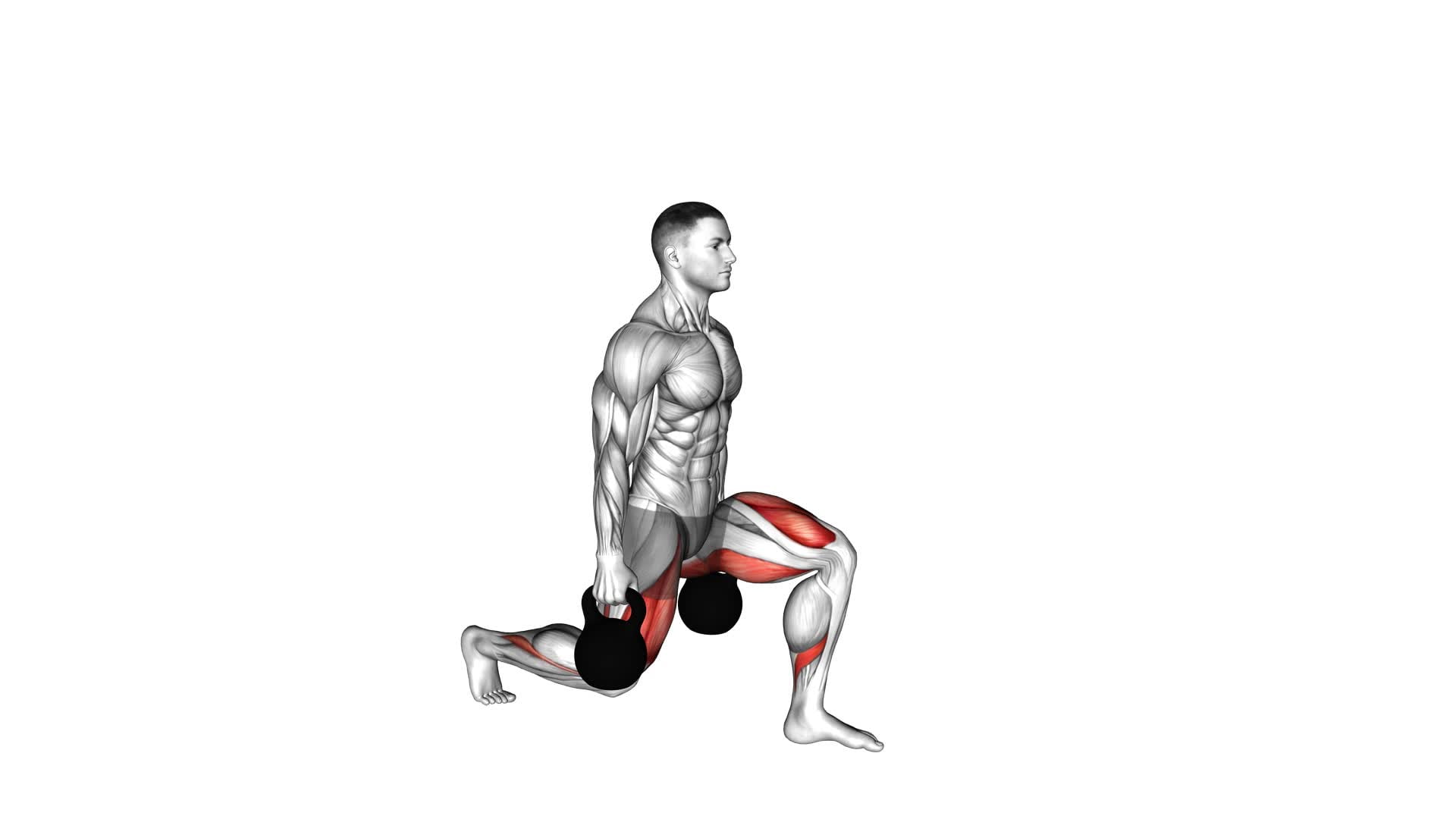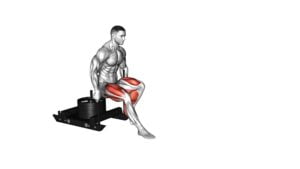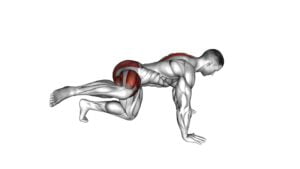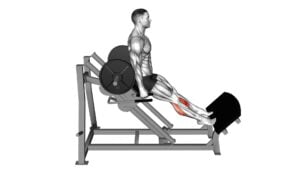Kettlebell Backward Lunge – Video Exercise Guide & Tips

Are you looking to add a challenging exercise to your workout routine?
Watch This Exercise Video
The Kettlebell Backward Lunge is a great option that targets your lower body and improves balance and stability.
In this video exercise guide, we'll show you the proper form and technique to perform this lunge with a kettlebell.
Whether you're a beginner or a seasoned fitness enthusiast, we have tips and modifications to help you get the most out of this exercise.
Let's get started!
Key Takeaways
- The Kettlebell Backward Lunge targets lower body muscles and improves balance and stability.
- Proper form and technique include standing tall with the kettlebell, taking a step backward into a lunge position, and maintaining alignment of the front knee and ankle.
- Common mistakes to avoid include leaning too far forward, not stepping back far enough, and neglecting to engage the glutes.
- When choosing the right kettlebell weight, it is important to assess strength and fitness level, start with a lighter weight for beginners, and gradually increase weight as proficiency improves.
Benefits of the Kettlebell Backward Lunge
You will experience numerous benefits when incorporating the kettlebell backward lunge into your fitness routine. This exercise isn't only effective for building lower body strength, but it also helps with injury prevention and muscle activation.
One of the key benefits of the kettlebell backward lunge is its ability to prevent injuries. By engaging multiple muscle groups, including the glutes, hamstrings, and quadriceps, this exercise helps to stabilize and strengthen the muscles surrounding your joints. This increased stability can reduce the risk of common injuries, such as sprains and strains, by improving balance and proprioception.
Furthermore, the kettlebell backward lunge is a highly effective exercise for muscle activation. As you step back into a lunge position, the muscles in your legs and core are engaged to support the movement. The added resistance from the kettlebell enhances the muscle activation, making it a great exercise for building strength and power in your lower body.
Incorporating the kettlebell backward lunge into your fitness routine can provide a wide range of benefits, including injury prevention and enhanced muscle activation. So, grab a kettlebell and start lunging your way to a stronger and healthier you.
Proper Form and Technique for the Exercise
To perform the kettlebell backward lunge with proper form and technique, follow these steps:
- Start by standing tall, holding the kettlebell in front of your chest with both hands.
- Take a step backward with one leg, lowering your body down into a lunge position.
- Keep your front knee aligned with your ankle, and your back knee hovering just above the ground.
- Push through your front heel to return to the starting position, and then repeat the movement with the opposite leg.
When performing the kettlebell backward lunge, it's important to avoid common errors that can compromise your form and effectiveness:
- Avoid leaning too far forward or backward, as this can put strain on your joints and decrease the effectiveness of the exercise.
- Don't allow your front knee to collapse inward, as this can lead to knee pain and instability.
- Maintain a straight back throughout the movement to avoid unnecessary stress on your lower back.
- Lastly, focus on proper breathing techniques during the kettlebell backward lunge. Inhale as you lower your body into the lunge, and exhale as you return to the starting position. This helps stabilize your core and maintain proper form.
Choosing the Right Kettlebell Weight
The key to choosing the right kettlebell weight is assessing your strength and fitness level. Proper weight selection is crucial for effective and safe kettlebell training. If you choose a weight that's too light, you won't challenge your muscles enough to see results. On the other hand, if you choose a weight that's too heavy, you risk injuring yourself. So how do you determine the right weight?
Start by considering your current fitness level and experience with kettlebell training. If you're a beginner, it's best to start with a lighter weight to focus on proper form and technique. As you become more comfortable and proficient, you can gradually increase the weight.
Another factor to consider is your overall strength. If you're able to perform exercises with ease using regular dumbbells or barbells, you may be able to handle a heavier kettlebell. However, if you're new to strength training, it's advisable to start with a lighter weight until you build up your strength.
Additionally, consider the specific exercise you'll be performing. Some exercises, like swings or cleans, require more explosive power and may require a heavier weight. Others, like overhead presses or Turkish get-ups, may require a lighter weight to focus on stability and control.
Common Mistakes to Avoid
Avoiding common mistakes is crucial when performing kettlebell backward lunges. Proper technique ensures that you maximize the benefits of the exercise while minimizing the risk of injury. Here are four common mistakes to avoid:
- Leaning too far forward: It's important to maintain an upright posture throughout the movement. Leaning too far forward puts excessive strain on your lower back and can lead to injury. Keep your chest lifted and your core engaged.
- Not stepping back far enough: When performing a backward lunge, make sure to take a big enough step back. This ensures that your front knee stays directly above your ankle, preventing unnecessary stress on your joints.
- Allowing your front knee to collapse inward: Keep your front knee in line with your toes throughout the entire movement. Allowing your knee to collapse inward puts stress on the knee joint and increases the risk of injury. Focus on keeping your knee aligned and tracking over your toes.
- Neglecting to engage your glutes: The backward lunge is a great exercise for targeting your glutes. To get the most out of the movement, actively squeeze your glutes as you push off your back foot and return to the starting position.
Modifications and Progressions for All Fitness Levels
Now let's talk about modifications and progressions for all fitness levels when it comes to the kettlebell backward lunge.
If you're a beginner, you can start by using a lighter kettlebell or even just bodyweight until you feel comfortable with the movement.
For more advanced individuals, you can increase the weight of the kettlebell or even add additional reps or sets to challenge yourself further.
Remember to always listen to your body and adjust the exercise accordingly to ensure safety and effectiveness.
Beginner Modifications for Lunge
To modify the lunge for beginners, start by using a lighter weight kettlebell. Here are some beginner modifications and variations for the lunge:
- Partial Range of Motion: Perform the lunge with a smaller step, allowing your back knee to come closer to the ground. This reduces the stress on your joints and builds strength gradually.
- Bodyweight Lunges: Begin by doing lunges without any weights. This helps you focus on your form and balance, ensuring proper technique before adding resistance.
- Assisted Lunges: Hold onto a stable object, like a chair or wall, for support while performing lunges. This helps with stability and reduces the risk of falling.
- Split Squats: This variation involves keeping your feet stationary and lunging forward with one leg at a time. It's a great way to build strength and stability in a more controlled manner.
By implementing these modifications, you can safely and effectively progress towards more advanced variations of the lunge.
Now, let's explore advanced progressions for the lunge.
Advanced Progressions for Lunge
To advance your lunge exercise and challenge yourself further, there are several advanced modifications and variations that can be incorporated for all fitness levels.
One option is the weighted lunge, where you hold dumbbells or kettlebells in your hands while performing the lunge. This increases the resistance and adds an extra challenge to your muscles.
Another option is the jumping lunge, where you explosively jump and switch legs in mid-air during the lunge. This adds a plyometric element to the exercise, increasing power and cardiovascular fitness.
Additionally, you can try the deficit lunge, where you stand on an elevated surface such as a step or platform and perform the lunge from a lower position. This increases the range of motion and targets the muscles differently.
Incorporating these advanced modifications and variations will help you continue to progress and improve your lunge exercise.
Tips for Incorporating the Kettlebell Backward Lunge Into Your Workout Routine
When incorporating the kettlebell backward lunge into your workout routine, it's important to focus on maintaining proper form and engaging your muscles throughout the movement. Here are some tips to help you make the most of this exercise:
- Start with a lighter kettlebell: Since the backward lunge can be challenging, especially when holding a kettlebell, it's best to begin with a weight that you can comfortably handle. Gradually increase the weight as you build strength and confidence.
- Maintain an upright posture: Keep your chest lifted and shoulders back throughout the movement. This will help engage your core and prevent any strain on your lower back.
- Step back with control: When lunging backward, take a controlled step back and lower your body until your front thigh is parallel to the ground. Avoid rushing or haphazard movements to ensure proper form and reduce the risk of injury.
- Focus on the mind-muscle connection: Concentrate on engaging the muscles in your legs, particularly your glutes and quads, as you push back up from the lunge position. This will help you maximize the benefits of the exercise.
Frequently Asked Questions
How Many Sets and Repetitions Should I Do of the Kettlebell Backward Lunge?
To determine the number of sets and repetitions for the kettlebell backward lunge, consider your fitness goals and current level of strength. Start with 2-3 sets of 8-12 repetitions per leg. Adjust the intensity by selecting an appropriate kettlebell weight.
Performing the exercise correctly engages your glutes, hamstrings, and quadriceps while improving balance and stability. Incorporating kettlebell backward lunges into your workout routine can enhance lower body strength and overall functional fitness.
Can I Do the Kettlebell Backward Lunge if I Have Knee or Back Pain?
If you have knee or back pain, modifications can be made to the kettlebell backward lunge to accommodate your needs. This exercise can actually be beneficial for those with knee and back pain, as it helps to strengthen the muscles around those areas.
However, it's important to listen to your body and not push through any pain. If necessary, consult with a fitness professional for guidance on how to properly modify the exercise to suit your needs.
How Often Should I Incorporate the Kettlebell Backward Lunge Into My Workout Routine?
To get the most out of your workout routine, it's important to incorporate the kettlebell backward lunge regularly. This exercise offers numerous benefits, such as improving lower body strength, stability, and balance. By performing the kettlebell backward lunge with proper form and technique, you can target your glutes, quads, and hamstrings effectively.
Make sure to engage your core, keep your chest up, and take controlled steps backward. Adding this exercise to your routine will help you achieve your fitness goals.
Are There Any Alternative Exercises to the Kettlebell Backward Lunge That Target the Same Muscle Groups?
Looking for alternative exercises that target the same muscle groups as the kettlebell backward lunge?
There are a few options you can try. Consider incorporating exercises like the dumbbell reverse lunge, barbell rear lunge, or even the walking lunge into your routine.
These exercises not only engage similar muscle groups, but also provide variety to keep your workouts interesting and challenging.
Give them a try and see which ones work best for you!
Can I Use a Dumbbell or Other Weighted Object Instead of a Kettlebell for the Backward Lunge Exercise?
Yes, you can use a dumbbell or other weighted object instead of a kettlebell for the backward lunge exercise. This provides you with dumbbell options and allows you to still target the same muscle groups.
Conclusion
The kettlebell backward lunge is a highly effective exercise for improving lower body strength and stability. By incorporating this exercise into your workout routine, you can target your glutes, hamstrings, and quads while also engaging your core.
Remember to maintain proper form and choose the appropriate kettlebell weight to avoid injury. With modifications available for all fitness levels, this exercise can be tailored to meet individual needs.
Start incorporating the kettlebell backward lunge into your workouts to take your fitness to the next level.

Author
Years ago, the spark of my life’s passion ignited in my mind the moment I stepped into the local gym for the first time. The inaugural bead of perspiration, the initial endeavor, the very first surge of endorphins, and a sense of pride that washed over me post-workout marked the beginning of my deep-seated interest in strength sports, fitness, and sports nutrition. This very curiosity blossomed rapidly into a profound fascination, propelling me to earn a Master’s degree in Physical Education from the Academy of Physical Education in Krakow, followed by a Sports Manager diploma from the Jagiellonian University. My journey of growth led me to gain more specialized qualifications, such as being a certified personal trainer with a focus on sports dietetics, a lifeguard, and an instructor for wellness and corrective gymnastics. Theoretical knowledge paired seamlessly with practical experience, reinforcing my belief that the transformation of individuals under my guidance was also a reflection of my personal growth. This belief holds true even today. Each day, I strive to push the boundaries and explore new realms. These realms gently elevate me to greater heights. The unique combination of passion for my field and the continuous quest for growth fuels my drive to break new ground.



